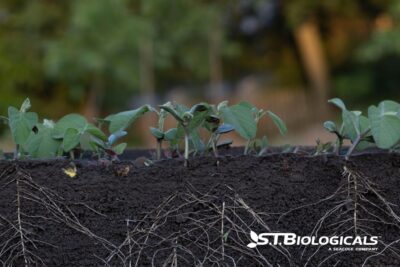Regenerative agricultural practices are gaining momentum. Partly due to the potential to restore soil health and mitigate environmental damage, but also because it’s profitable.
Regen Agriculture: More Profitable Than Conventional Agriculture?
It’s simple. Fewer costly inputs to buy, fewer passes through the field, and better crop resilience to extreme weather events. That leads to higher profits.
One of the challenges farmers face is the efficient delivery of nutrients to plants. Let’s face it, fertilizers have increased yield/acre from 100.7 bu in 1993 to a projected yield/acre for 2023 of 181.5 bu. All all-time high!
But does higher productivity always mean higher profits?
According to the Iowa Farm Bureau, farmers in that state haven’t made a profit growing corn in the last 5 years. (1)
USDA statistics show the average profit per acre for corn in the Northern Plains in 2022 was $101.30. There’s a profit, but it’s mighty slim. (2)
The costs of inputs have skyrocketed. And those costs don’t factor in the environmental and health costs associated with fertilizer production.
We’ve used corn as an example of the problems facing conventional ag producers. All commodity crops are facing these same market/production cost issues. One way to create higher profit margins is to increase the efficiency of your fertilization program.
Precision delivery with GPS systems and tracking, cover crops, and no-till keep more nutrients in the fields. Converting acreage to regenerative practices builds soil health which leads to higher nutrient profiles in your crops. Over time mycorrhizal fungi and beneficial bacterial populations multiply, and soil organic matter increases.
Regen ag practices are less costly because there are fewer inputs. Nature does a lot of the heavy lifting to maintain crop yields while improving soil structure. When you convert acres to regen you’re looking at the big picture.
You’re developing your soil so your farm will be able to handle whatever extreme climate events occur in the future.
This takes time. But in the meantime…
…this is where nanoparticles come in.
Nanoparticle Tech Makes Regen Ag Profitable Quickly
Liquid fertilizers are gaining ground. They’re more effective, and they minimize environmental impacts. Adding nanoparticle technology to your regular fertilization plan aids in rapid plant uptake of nutrients.
Nanoparticles encapsulate the fertilizer molecules, then release them slowly and in a controlled manner. This method enhances the fertilizer’s efficiency, as it reduces nutrient leaching and volatilization. Ultimately, this minimizes the negative environmental consequences associated with traditional fertilizer application.
The Benefits of Nanoparticles for Soil Health
Nanoparticles have been shown to have a positive effect on soil microbial communities. Soil fertility and corn growth are improved with the addition of nanoparticles to fertilization. (3) Healthy soil is the key to resilient crops. And healthy soil is full of microorganisms. PGPR (plant growth-promoting rhizobacteria) is one type of soil microorganism that responds well to nanoparticle products. These bacteria are found in the plant rhizosphere and protect plants from both biotic and abiotic stresses.
Incorporating nanoparticle technology, regenerative ag farming practices, and PGPR in fields leads to improved soil health. Letting nature do more of the work means you need less fertilizer, pesticides, or fungicides.
When introduced into liquid fertilizers, nanoparticles provide a protective barrier, shielding vital nutrients from degradation and loss. By effectively encapsulating nutrients within their structure, nanoparticles ensure that a greater proportion of the fertilizers reach the plants’ roots, facilitating optimal absorption.
A recent study compared nanoparticles to bio-inoculants as adjuncts to fertilizers. Fertilizers with nanoparticles were more efficient because of their higher adhesion capacity. The encapsulation of nutrients in the nanoparticles was the distinguishing trait compared to bio-inoculants. The nutrient release was slow and for a prolonged period without leaching issues.
Traditional fertilizers often suffer from a considerable amount of nutrient loss due to leaching or volatilization. That impacts the overall effectiveness of the application.
Benefits of Nanoparticles for Regenerative Agriculture
The incorporation of nanoparticles in liquid fertilizers for regenerative agriculture offers several benefits.
#1 It promotes the efficient use of nutrients by plants, ensuring that their growth and development are optimized.
#2 Nanoparticles provide effective protection against nutrient loss, improving fertilizer use efficiency. This translates to cost savings for farmers, as they can reduce the amount of fertilizer needed while achieving comparable or better crop yields.
#3 The targeted and controlled release of nutrients by nanoparticles reduces the risk of pollution, promoting sustainable farming practices.
When you use nanoparticle technology with your fertilizer, you retain more nutrients within the plant structure. Wind and rain don’t have an opportunity to erode nanoparticles with their payloads of fertilizer ions. You enhance nutrient delivery, reduce waste, and improve overall agricultural productivity.
More nutrient retention – fewer passes across the field – more money in your pocket.
Nanoparticles and Farm Profitability
Including nanoparticles as a nutrient carrier offer a unique ability to tailor fertilizer formulations to meet specific crop and soil requirements better. Nanoparticle products have been developed for customized fertilizer solutions that release nutrients in a controlled and targeted manner.
This not only supports the goals of regenerative agriculture, such as soil health and biodiversity conservation but also contributes to the economic viability of farming operations.
To find out how to make your farm or ranch more profitable, contact our team at ST Biologicals. Soil speaks, we listen.

